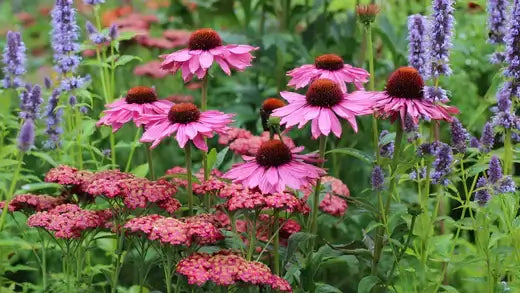In gardening, the pursuit of sustained beauty throughout the seasons often leads to the discovery of long-blooming perennials. These captivating plants have mastered the art of endurance, offering a prolonged burst of colors and life to any garden. Among the ranks of these enduring beauties, coneflowers, daylilies, blanket flowers, black-eyed Susans, and butterfly weeds stand as exceptional examples, each contributing their unique charm to the tapestry of the garden.
Coneflowers (Echinacea spp.)perennials:
A Majestic Journey Through Summer Coneflowers are some of the most celebrated long-blooming perennials with their iconic daisy-like appearance and distinctive cone-shaped centers. Native to North America, these plants have quickly transitioned from prairie landscapes to modern gardens. Their blooming season typically stretches from early summer well into the fall, offering a splash of colors that range from traditional purples and pinks to vibrant oranges and yellows. The allure of coneflowers lies not only in their visual appeal but also in their ecological significance. The showy blossoms serve as a pollinator feast, attracting butterflies, bees, and birds, thus contributing to the ecosystem's overall health. With their robust nature, coneflowers require minimal care, thriving in well-drained soil and under full sunlight. As the summer sun warms the garden, these enduring perennials stand as a testament to nature's ability to grace us with beauty that withstands the test of time.
Daylilies (Hemerocallis spp.) perennials:
A Parade of Ever-Changing Elegance Daylilies, often called the "perfect perennial," are renowned for their breathtaking beauty and adaptability. These plants derive their name from the fleeting nature of their blossoms, which typically last only a day. However, their unique charm lies in the profusion of blooms they produce over an extended period. Daylilies come in an astonishing array of colors, from pure whites and soft pastels to deep oranges and rich reds. What distinguishes daylilies is their diverse growth habits, encompassing a range of sizes and forms. Some varieties are diminutive and ideal for borders, while others boast tall scapes that create an impressive backdrop. Their adaptability to various soil types and light conditions makes them a staple in gardens worldwide. With proper care and division, daylilies can continue to thrive and grace the park with their ephemeral elegance for many years.
Blanket Flowers (Gaillardia spp.) perennials:
A Riot of Colorful Endurance Blanket flowers, named for their vibrant hues that evoke the patterns of Native American blankets, are another exceptional example of long-blooming perennials. These cheerful plants bloom profusely from early summer to frost, showcasing striking reds, yellows, and oranges. Their daisy-like blossoms are often adorned with intricate patterns and a central disk contrasting beautifully with the surrounding petals. Originating from the prairies of North and South America, blanket flowers are naturally suited to withstand various growing conditions, including drought and poor soil. Their toughness and appeal to pollinators like bees and butterflies make them an excellent choice for experienced and novice gardeners. Whether used in mass plantings or as accent features, blanket flowers contribute a burst of color that enlivens any outdoor space.
Black-Eyed Susan's (Rudbeckia spp.) perennials:
Sun-Kissed Delights That Endure Black-eyed Susan's, with their sunny disposition and distinctive dark centers, hold a special place in the hearts of garden enthusiasts. These long-blooming perennials are native to North America and are celebrated for their ability to thrive in various soil types and light conditions. Their bright, golden-yellow petals radiate warmth, symbolizing summer that lasts well into fall. These resilient plants bring aesthetic delight and play a crucial role in supporting wildlife. Their nectar-rich blossoms attract pollinators, while their seeds nourish birds during the colder months. Black-eyed Susan's are known for their low maintenance requirements, making them popular for those seeking a charming yet enduring addition to their gardens.
Butterfly Weed (Asclepias tuberosa) perennials:
Nurturing Nature's Winged Wonders As its name suggests, butterfly weed is a perennial that delights in attracting butterflies and other pollinators. Native to North America, this plant plays a vital role in supporting the lifecycle of monarch butterflies as a primary host for their caterpillars. Its vibrant orange flowers, clustered atop sturdy stems, make a beautiful contrast against the greenery. The blooming period of butterfly weed typically spans from early summer to mid-fall, making it an enduring source of nectar for pollinators during their migration journeys. Despite its delicate appearance, butterfly weed is surprisingly hardy and drought-tolerant once established. Its ability to thrive in challenging conditions and its vital role in promoting biodiversity has earned it a place in the hearts of both gardeners and conservationists.
Delightful Perennials:
The enchanting world of long-blooming perennials offers a captivating journey through the changing seasons, reminding us of the resilience and beauty that nature bestows upon us. Coneflowers, daylilies, blanket flowers, black-eyed Susan's, and butterfly weeds are prime examples of this enduring charm. From the daisy-like blooms of coneflowers to the ever-changing elegance of daylilies, the riotous colors of blanket flowers, the sun-kissed delight of black-eyed Susan's, and the crucial role of butterfly weed in supporting pollinators, each of these perennials brings a unique story to the garden. As they stand firm and vibrant year after year, they remind us of the enduring magic that the natural world shares with us.
Purple Coneflower Plant





